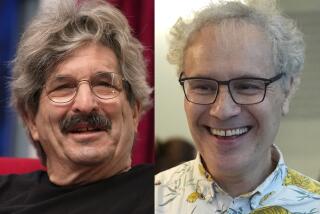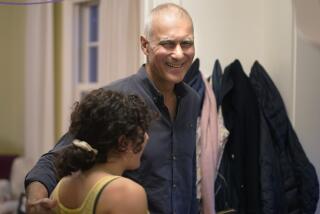A Diverse Man for the Greater Good
- Share via
If there were maps to the real stars’ homes in Southern California, they’d lead directly to Pasadena. That’s where the great Linus Pauling lived and worked for more than 40 years, and where he became a household name and the only person in history to win two unshared Nobel Prizes (one for chemistry, the second for efforts at world peace).
The charismatic chemist and humanitarian (tall, handsome and usually en beret) died in 1994 at his ranch in Big Sur. But he lives again, in a sense, through a delightful new exhibit, “Linus Pauling and the Twentieth Century,” which illuminates his life and his astoundingly diverse work.
If you or your offspring (grades six through 12) love lasers, molecular theory, quantum anything--or just the study of great men and great minds--then this gem-like multimedia exhibit is the place to go. It offers photos, diaries, notebooks, molecular models, historical artifacts and interactive educational displays that even unscientific minds can enjoy and appreciate.
Pauling’s first Nobel prize (1954) was for applying quantum theory to explain the molecular bonding process. He also developed rocket fuel and an oxygen meter still in use today. He worked on the structure of DNA, the structure of proteins, discovered that sickle cell anemia was a molecular disease and was possibly best-known in the non-science community for popularizing the benefits of vitamin C.
But there were at least two other Linus Paulings living inside him. One was the devoted family man--a guy who fell madly in love at age 22 and remained that way through 60 years of marriage and the raising of four children. His family was his priority, says daughter Linda Pauling Kamb, who lives with her husband, Barclay (a Caltech professor), in papa Pauling’s original Pasadena homestead to this day.
The third Linus Pauling was a social activist--a man so concerned about humanity’s survival in the nuclear age that he started working in the 1950s to limit the spread of atomic weapons, and actually walked picket lines with signs urging a ban on nuclear testing in the Earth’s atmosphere. This did not make him popular at Caltech, where he had been a distinguished member of the faculty, or with the FBI, which launched what became a 24-year investigation that included the revocation of his passport, and loss of his security clearance and of government grants.
Pauling survived all this and more, simply by outworking, outliving and outloving those who sought to do him in. If you want to know more about this mega-mind and unsinkable optimist, see this free exhibit before it heads for the Smithsonian Institution in Washington, D.C.
“Linus Pauling and the Twentieth Century” is on display through June 19 at Caltech’s Winnett Center, 1200 E. California Blvd., Pasadena. (323) 938-8255.






